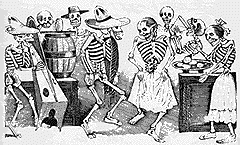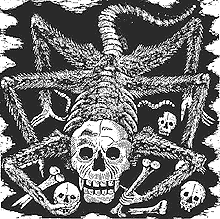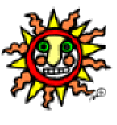THE SPIRIT OF POSADA
 The
name Posada and lively skeletons are linked as few other icons of
contemporary Day of the Dead culture. Jose Guadalupe Posada (1852-1913)
popularized Mexico's life of the dead in bitingly satiric, mass-produced
etchings and lithographs that have enthralled Mexicans for generations. The
name Posada and lively skeletons are linked as few other icons of
contemporary Day of the Dead culture. Jose Guadalupe Posada (1852-1913)
popularized Mexico's life of the dead in bitingly satiric, mass-produced
etchings and lithographs that have enthralled Mexicans for generations.
By depicting social and political personalities as calaveras,
Posada's posters achieved lasting and unrivaled popularity. By
caricaturing his targets in their bare bones, his scathing and often
risky political satire became funnier and thus more acceptable.
 In his posters, priests, politicians, farmers and streetsweepers share
the same destiny - death, an end neither money nor power can outwit. For
a country living in extreme social inequality during the Porfirio Díaz
dictatorship, the idea of the rich and poor alike one day rubbing elbows
(if only bone to bone) was attractive to the masses.
In his posters, priests, politicians, farmers and streetsweepers share
the same destiny - death, an end neither money nor power can outwit. For
a country living in extreme social inequality during the Porfirio Díaz
dictatorship, the idea of the rich and poor alike one day rubbing elbows
(if only bone to bone) was attractive to the masses.
Posada's handprinted calaveras, accompanied by witty social
commentary in rhyming verse, reached the farthest corners of the Mexican
Republic. To this day, his work pervades the image and spirit of Mexican
folk artists. The Catrina, an upperclass lady of the
turn-of-the-century always depicted in her broad-brimmed hat, has become
a classic in Mexican folk art and is displayed prominently in many store
windows. The images can be found in everything from fine ceramic and
artistic paper mache figures, to inexpensive papel picados and
plaster miniatures.
Nothing is static about Posada's calaveras (mischievous
skeletons). They are always up to something, going somewhere or, as in
the Calavera Oaxaquena, just raising hell.
This information comes from:
http://www.mexconnect.com/mex_/travel/mjmendoza/mjmdiadelasmuertos.html |
 ¡En español!
¡En español!
 ¡En español!
¡En español!